Sprained your knee and wondering how to bounce back fast? You're not alone. Knee pain affects 1 in 4 adults, and its prevalence has shot up by 65% in the last two decades. Whether it's from a twist, fall, or awkward landing, knowing how to heal a sprained knee quickly can make all the difference. In this guide, we’ll walk you through expert-backed steps to reduce swelling, manage pain, protect your knee joint, and safely return to your workout routine.
Key Takeaways
-
Immediate action, including the RICE protocol (Rest, Ice, Compression, Elevation), is critical for managing a sprained knee and reducing recovery time.
-
Knee braces provide necessary support during recovery, helping to stabilize the joint and prevent re-injury through various types tailored to specific needs.
-
Effective pain management and a personalized rehabilitation plan, emphasizing proper nutrition and gradual return to activity, are essential for optimal healing and future injury prevention.
Immediate Actions to Take Post-Injury
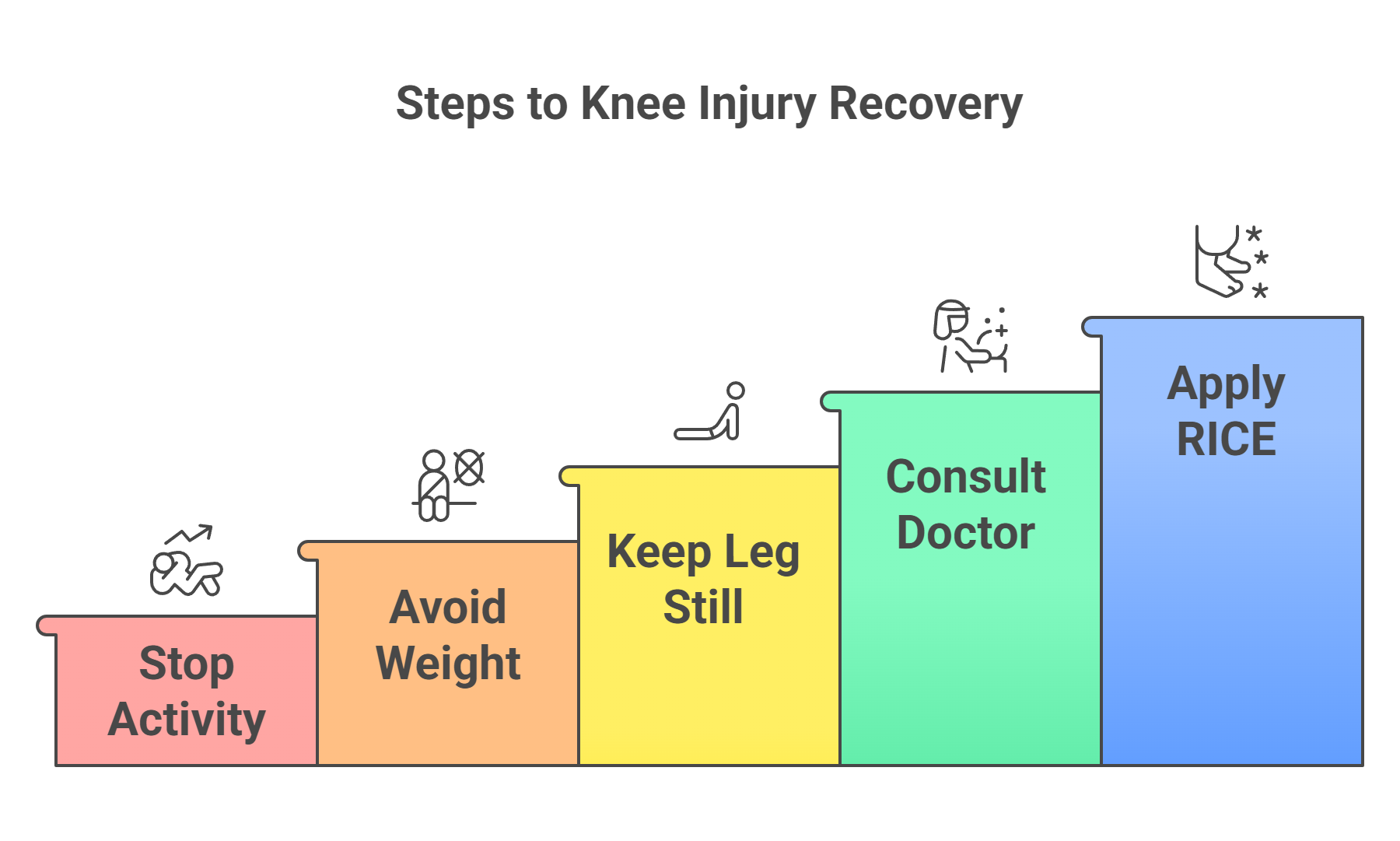
The moment you sprain your knee, how you respond in the first few minutes can set the tone for your entire recovery.
Here’s what to do right away:
-
Stop all physical activity to prevent further damage.
-
Avoid putting any weight on your injured knee. Use crutches if needed.
-
Keep the leg still and avoid twisting, bending, or walking on it until you’ve been evaluated.
These early steps help protect the injured area and avoid worsening the sprain. If you experience significant swelling, limited movement, or sharp pain that lasts longer than 48 hours, consult a doctor or orthopedic specialist for a proper diagnosis. Early intervention can shorten recovery time and prevent long-term knee issues.
Once the injury is stabilized, your next move is to apply the RICE method.
Applying the RICE Protocol
As Cleveland Clinic advises, the RICE method (Rest, Ice, Compression, and Elevation) is a long-standing and effective approach for managing acute soft tissue injuries like a minor knee sprain, moderate knee sprains, or even a more severe sprain.
While newer strategies are emerging, RICE remains a trusted first-line response, especially in the early hours after injuring your knee joint.
Here’s how to apply RICE properly for faster healing and better knee sprain recovery time:
Rest
Rest is necessary to avoid further harm and enable natural healing processes. Avoid any activities that may stress the knee further until the swollen swelling subsides. Use crutches or other aids to prevent weight-bearing on the injured leg due to a minor knee sprain, a sprained knee, and anterior cruciate injury.
Rest should be maintained until pain significantly decreases, providing the stability needed for the knee to heal properly.
Ice
Ice application is key for reducing swelling and managing pain. Use an ice pack for 15-20 minutes every 2-3 hours during the first 48-72 hours. Always use a barrier, such as a cloth, to prevent ice burns or skin damage.
Ice therapy can also help numb the area, reducing pain perception. Continue regular icing until swelling and pain are under control.
Compression
Compression helps control swelling and provides joint support. Use an elastic bandage to wrap the knee, ensuring not to wrap too tightly to avoid restricting blood flow. Adjust the compression level based on swelling and discomfort.
Elevation
Elevation is another critical aspect of the RICE protocol. To maximize its benefits:
-
Keep the knee elevated above heart level as much as possible, especially in the first 48 hours.
-
This assists in reducing swelling and promoting fluid drainage.
-
Incorporate elevation into rest periods.
Use pillows or cushions to elevate the knee when lying down.
A note from Cleveland Clinic:
"The RICE method is good for immediate relief, but when it comes to long-term recovery, it's important to allow the process of inflammation to work. Ask your healthcare provider if the RICE method is appropriate for you." Source
For many cases of a knee sprain, especially a minor or moderate one, using the RICE protocol properly within the first 48 hours can prevent the injury from worsening and support healing.
However, always follow up with a healthcare provider to rule out more serious damage, such as ligament tears. This is especially important if your injured knee shows signs of instability or ongoing pain.
The Role of Knee Braces in Recovery
Knee braces can play an important part in recovery after a sprain, especially when used with proper guidance and at the right stage of healing. They help stabilize the knee joint, offer support during movement, and reduce the risk of further damage. However, not all braces are equally effective, and how they’re used matters just as much as when they’re used.
As the Mayo Clinic explains, braces can offer support, compression, and even pain relief, but results may vary depending on the type of brace, the injury, and your activity level. Let’s take a closer look at what kinds of braces are available and how they may support your recovery process.
Types of Knee Braces
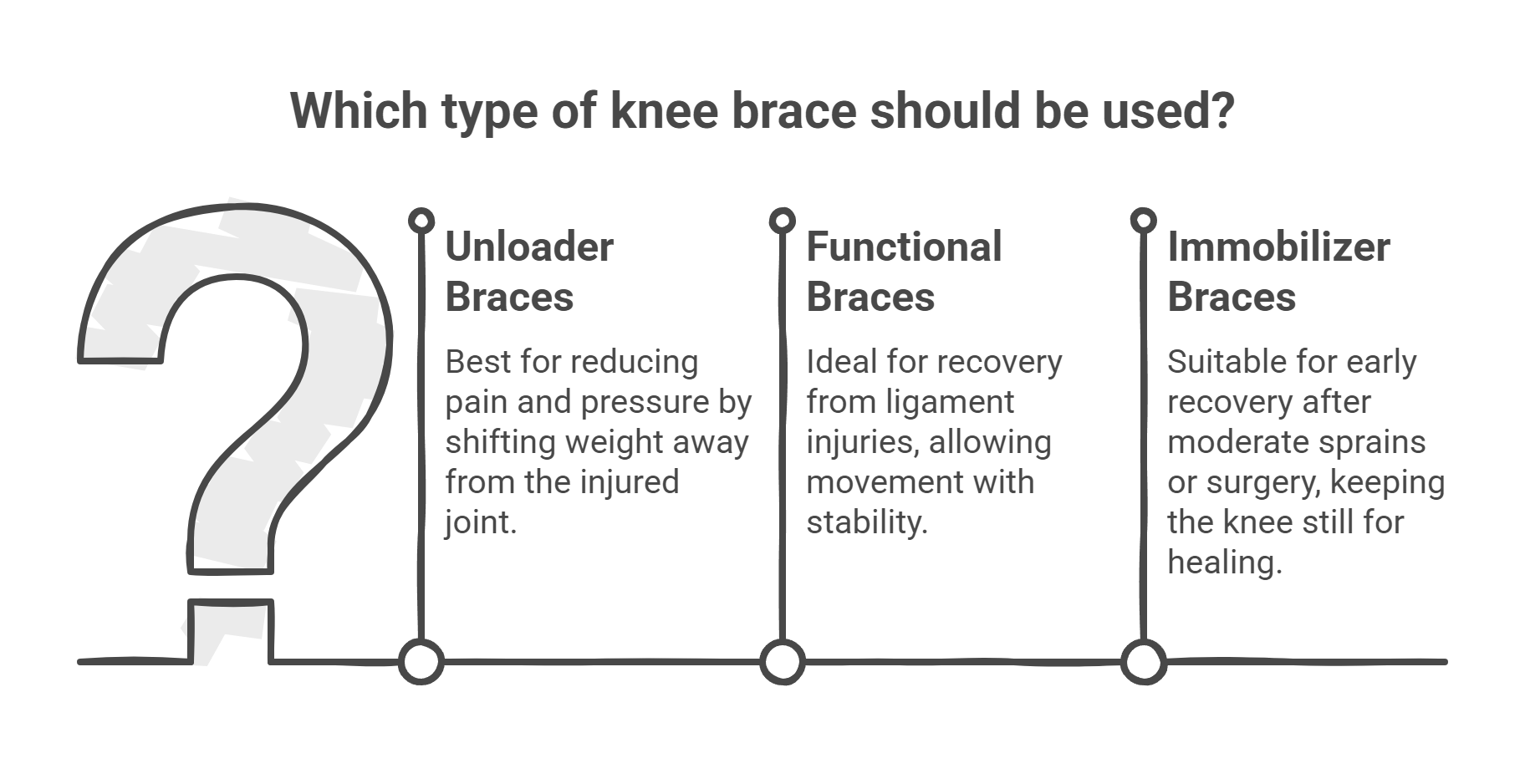
Different knee braces are designed for different purposes. Knowing which one to use depends on your injury and your activity level:
-
Unloader Braces: Help shift weight away from the injured knee joint to reduce pain and pressure.
-
Functional Braces: Commonly used during recovery from ligament injury. These allow movement while providing stability.
-
Immobilizer Braces: Used in the early stages of recovery after a moderate knee sprain, complete tear, or surgery. They keep the knee still to allow healing.
According to the Mayo Clinic, braces like neoprene sleeves may help relieve knee pain from mild sprains or early arthritis by providing warmth and compression. More complex braces are often used short-term for support after major injuries or surgery, especially involving the anterior cruciate ligament (ACL).
Benefits of Using Knee Braces
Used correctly, knee braces offer several benefits that may help during and after your healing process:
-
Reduce pain and provide stability in a healing knee.
-
Enhance proprioception, which improves your awareness of knee movement.
-
Support the knee joint during physical activity or physical therapy.
-
Prevent future injuries in knees with a history of sprain or strain.
One study published in the Journal of Bone and Joint Surgery found that some functional braces reduced strain on the anterior cruciate ligament under low stress loads. However, they were less effective under the higher forces typically involved in athletic movement.
When to Wear a Knee Brace
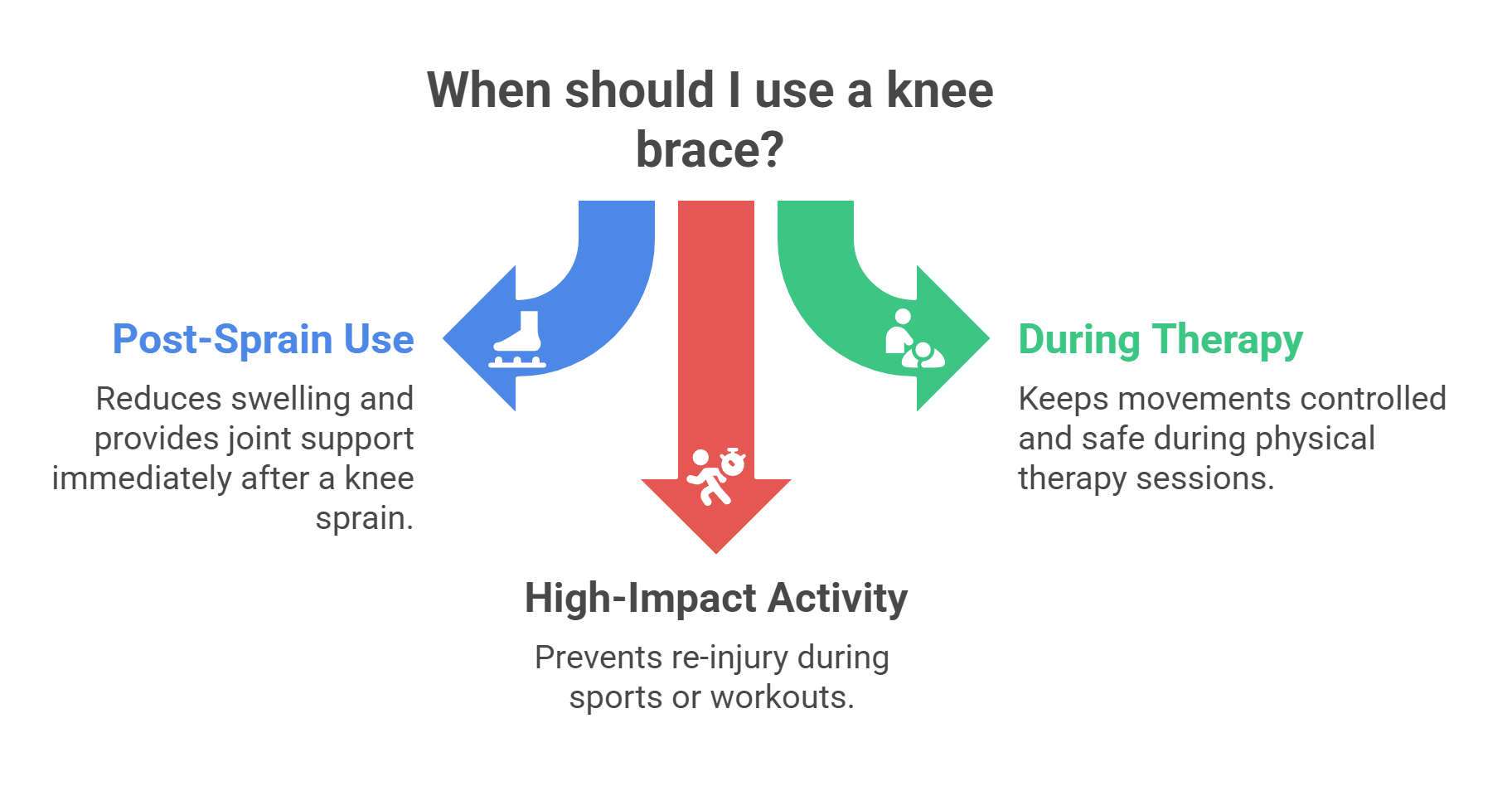
Using a knee brace at the right time is critical. Here's when you might consider wearing one:
-
Right after a knee sprain to reduce swelling and provide joint support.
-
During physical therapy to keep movements controlled and safe.
-
In high-impact physical activity (like sports or workouts) to prevent re-injury.
Knee braces can offer extra confidence, especially if you're dealing with an injured knee, mild sprains, or recovering from a more severe sprain. But remember, they are not a cure and should never replace professional guidance.
The Mayo Clinic advises tapering off brace use as you regain strength and stability. Prolonged reliance can reduce your knee’s ability to support itself. A healthcare professional or physical therapist can help you choose the right type and usage plan.
Knee braces are only one piece of a full treatment plan. For best results, combine them with rest, ice compression and elevation, gentle exercises, and guidance from a healthcare provider.
Need Support While You Heal? Protect your injured knee and move with more confidence during recovery with the Anaconda Knee Brace. It’s trusted by over 150,000 athletes and designed for maximum comfort, joint stability, and pain relief, whether you're managing a minor knee sprain or recovering from a more severe injury.
Pain Management Strategies
Effectively managing pain after a knee injury is essential to staying mobile and starting the healing process.
Whether you're dealing with a minor knee sprain, complete tear, or multiple ligament involvement, combining conservative options like gentle movement, natural remedies, and medication, under medical supervision, may help you reduce pain, prevent further damage, and support a more comfortable recovery time.
As always, consult a healthcare professional for an accurate diagnosis and to create a safe, tailored treatment plan, especially if you notice unusual symptoms such as extreme swelling, internal bleeding, or lingering stiffness after the injury happened.
Over-the-Counter Pain Relief Options
According to Yale Medicine, the two most common types of over-the-counter (OTC) medications for musculoskeletal injuries are NSAIDs (nonsteroidal anti-inflammatory drugs like ibuprofen, naproxen, and aspirin) and acetaminophen. Each has unique benefits and risks.
NSAIDs can reduce inflammation, swelling, and pain, making them potentially more helpful for soft tissue injuries like sprains or mild ligament injury.
Acetaminophen may be appropriate when inflammation isn't the main concern and is often recommended for those with sensitivities to NSAIDs or when avoiding blood-thinning effects.
“Over-the-counter medicines can be very helpful, but people need to take them with caution,” says Dr. Donna-Ann Thomas, Chief of Pain Medicine at Yale Medicine. “It’s important to follow the directions on the label, especially if you have medical issues or take other medications.”
— Yale Medicine, Sept 2025
Use these medications only as directed and avoid combining them unless advised by a medical professional. Some may interact with other prescriptions or increase risks like stomach issues, high blood pressure, or heart complications.
Natural and Nutritional Support for Pain
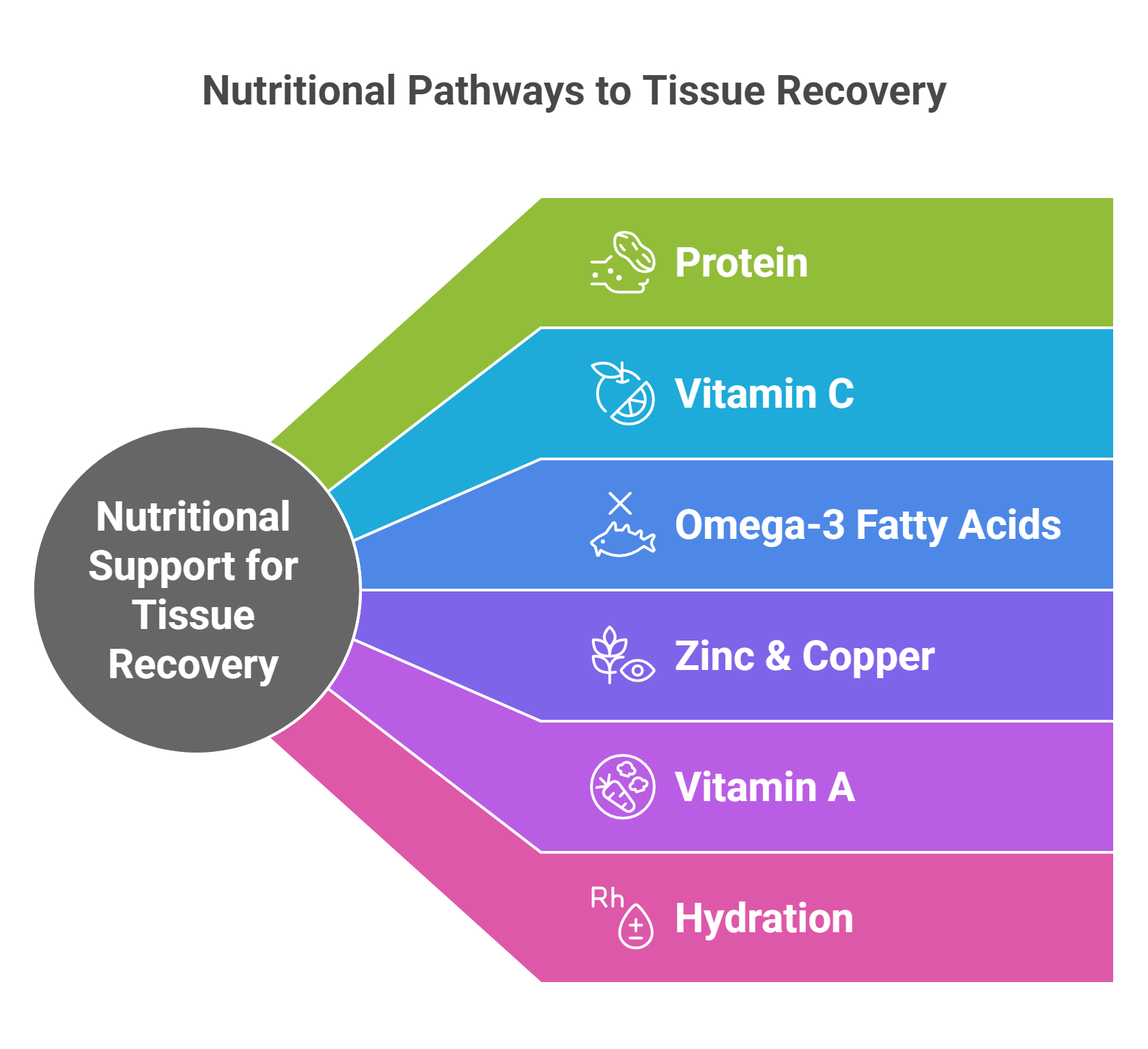
In addition to OTC options, incorporating anti-inflammatory foods and key nutrients into your daily meals may support tissue recovery and relieve pain or dull ache during rehabilitation.
According to the San Diego Orthobiologics Medical Group, certain vitamins and minerals play a key role in collagen production and tissue repair. Nutrition cannot replace physical therapy, but it may influence how efficiently tendons and knee ligaments heal.
Nutrients that Support Pain Reduction and Healing:
-
Protein: Helps rebuild damaged tissues.
Sources: Lean meats, Greek yogurt, eggs, legumes, bone broth -
Vitamin C: Aids in collagen production and protects healing tissue.
Sources: Bell peppers, strawberries, citrus fruits -
Omega-3 Fatty Acids: Help reduce chronic inflammation.
Sources: Salmon, chia seeds, flaxseeds, walnuts -
Zinc & Copper: Support connective tissue repair.
Sources: Pumpkin seeds, cashews, whole grains -
Vitamin A: Important for immune function and tissue regeneration.
Sources: Carrots, spinach, sweet potatoes -
Hydration: Dehydrated tissues heal slower.
Drink water consistently, especially during physical activity or gentle exercises.
One study published in the American Journal of Clinical Nutrition found that taking collagen or gelatin supplements with vitamin C before rehab exercises improved collagen synthesis in ligaments, potentially aiding long-term recovery.
Cold Therapy and Ice Packs
Using an ice pack during the first 48–72 hours can help reduce pain, swelling, and discomfort from a common injury like a knee sprain.
-
Wrap the ice in a thin cloth to prevent skin irritation.
-
Apply for 15–20 minutes every 2–3 hours.
-
Ice is most effective shortly after the injury happened and may not be needed long-term.
As Cleveland Clinic explains, cold therapy is helpful in the acute phase of injury but may not speed long-term recovery if overused. It's best to pair it with compression and elevation for maximum effect.
— Cleveland Clinic – RICE Method
When to Seek Further Evaluation
If your pain is worsening or you're unable to perform gentle movement without discomfort, it could point to a more severe sprain, a complete tear, or hidden complications. Always contact a healthcare professional if you:
-
Can’t walk or avoid putting weight on the leg
-
Experience significant swelling or internal bleeding
-
Suspect damage to multiple ligaments
-
Notice your recovery time is not improving with at home treatments
Getting timely care and the right treatment plan can prevent future sprains and help protect your knee from future injuries.
Physical Therapy and Rehabilitation
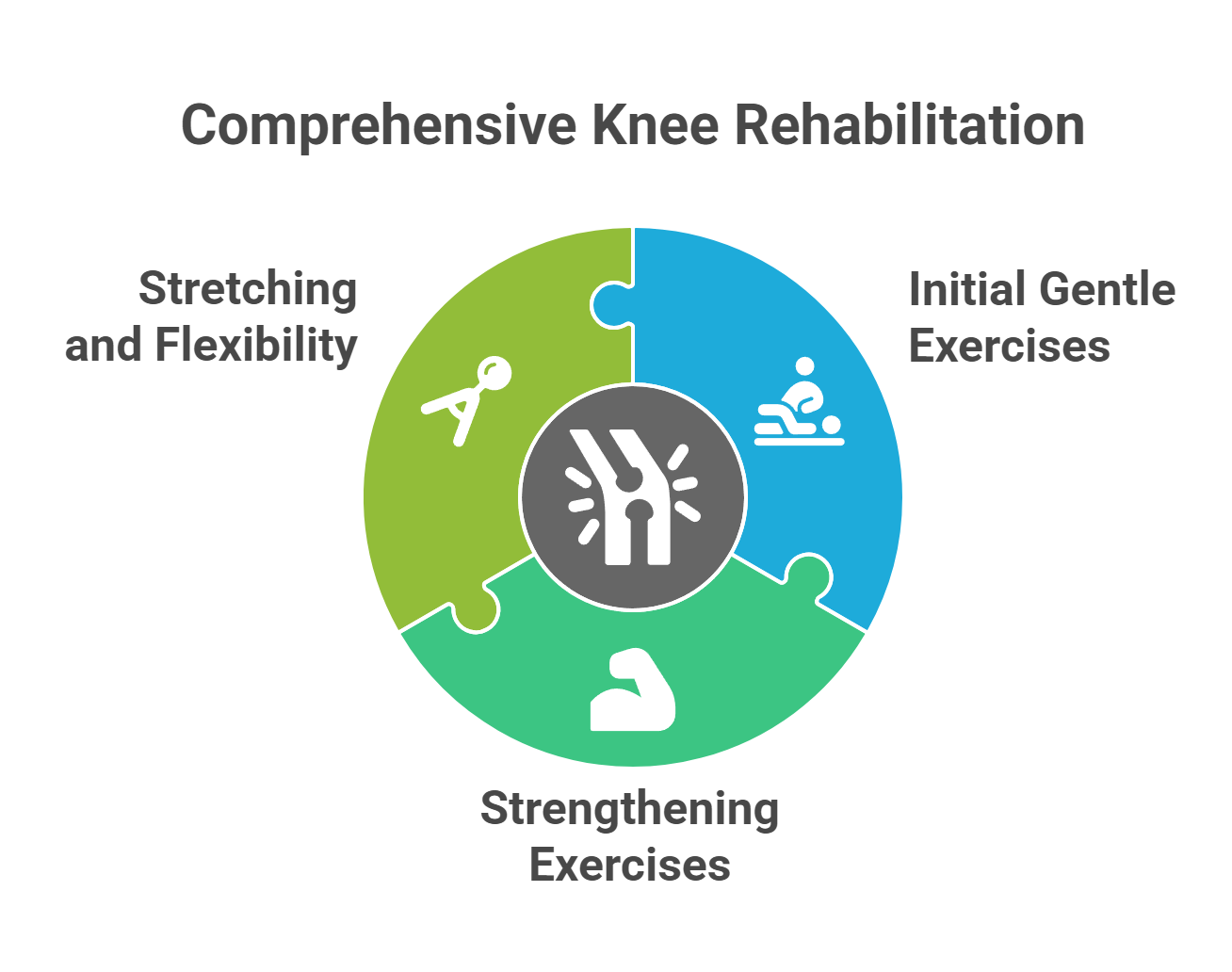
Physical therapy plays a major role in regaining strength, range of motion, and joint stability after a knee injury. Whether you're recovering from a minor knee sprain, moderate knee sprains, or a severe sprain, working with a physical therapist helps create a tailored treatment plan that fits your specific needs.
Therapists focus on strengthening the muscles around the knee joint, improving flexibility, and preventing stiffness, while avoiding movements that might aggravate the injured knee or slow down the healing process. This type of specialized treatment also supports knee sprain recovery time and long-term joint health.
In cases involving damage to the posterior cruciate ligament, medial collateral ligament, or lateral collateral ligament, physical therapy is especially important to protect the healing tissues and promote gradual progress without overloading the knee ligaments.
Initial Gentle Exercises
In the early phase of rehab, start with gentle movement to keep muscles engaged and limit atrophy.
-
Try isometric exercises like quad sets to activate muscles without moving the knee joint.
-
Leg slides and heel props can help maintain basic mobility without stressing the injured knee.
-
Gentle stretching promotes flexibility and reduces the risk of scar tissue buildup.
Incorporating light balance training early on helps restore control and reduce the chance of future injuries.
Strengthening Exercises
As your healing process progresses, shift toward strengthening the muscles that support the knee joint.
-
Use low-impact resistance exercises such as step-ups, resistance band leg presses, or wall sits.
-
Avoid high strain until your therapist confirms you're ready.
-
Include knee braces during certain movements for added support if needed, especially after a severe sprain.
Building muscle strength not only helps prevent future sprains but also reduces the likelihood of reinjury to structures like the posterior cruciate ligament.
Stretching and Flexibility
Stretching is key throughout recovery and beyond.
-
Focus on controlled movements to slowly expand your range of motion.
-
Hamstring, calf, and quadriceps stretches support the knee joint and surrounding muscle groups.
-
Do not overstretch, progress gradually and stop if you feel pain.
Combined with strength work, flexibility helps prepare your body for a full return to physical activity and can help improve outcomes across various knee sprain treatments.
Nutritional Support for Healing
Proper nutrition plays a pivotal role in tissue repair and recovery. Increasing protein intake supports muscle healing and regeneration. Incorporating anti-inflammatory foods can reduce swelling and promote faster recovery.
Addressing concerns about long-term health by emphasizing the role of nutrition in injury prevention is also crucial. A balanced diet aids in maintaining an active lifestyle and preventing future injuries.
Protein Intake
Adequate protein is essential for repairing muscles and connective tissue. According to a study published in National Library of Medicine, individuals in recovery may need 1.6 to 3.0 grams of protein per kilogram of body weight per day, depending on injury severity and level of activity.
-
Prioritize lean protein sources like chicken, fish, eggs, Greek yogurt, and legumes.
-
Whey protein and foods rich in leucine, like beef and dairy, may better support muscle protein synthesis.
-
Distribute protein intake evenly across meals and consume it before and after physical therapy sessions to optimize absorption.
This approach may help reduce pain, support tissue regeneration, and maintain strength while activity is limited.
Anti-Inflammatory Foods
Include foods like berries, fatty fish, and leafy greens to combat inflammation. Ginger and turmeric can be added to meals for their natural anti-inflammatory properties. A diet rich in antioxidants supports the body’s healing mechanisms.
Regular consumption of these foods enhances overall recovery and well-being.
Importance of Sleep and Rest
Adequate sleep is vital for the body’s healing processes and hormone regulation. Aim for 7-9 hours of quality sleep each night to support tissue repair. Rest reduces stress levels, creating an environment conducive to recovery.
A regular sleep schedule can significantly impact your overall recovery time.
Gradual Return to Physical Activity
Gradual reintroduction to physical activity minimizes the risk of re-injury. Follow these steps:
-
Start with low-impact exercises.
-
Slowly progress to sport-specific drills.
-
Ensure the knee is pain-free and fully mobile before returning to full training.
Get approval from a healthcare professional before engaging in intense activity. A structured exercise program should be monitored for safety and effectiveness.
Preventing Future Knee Injuries
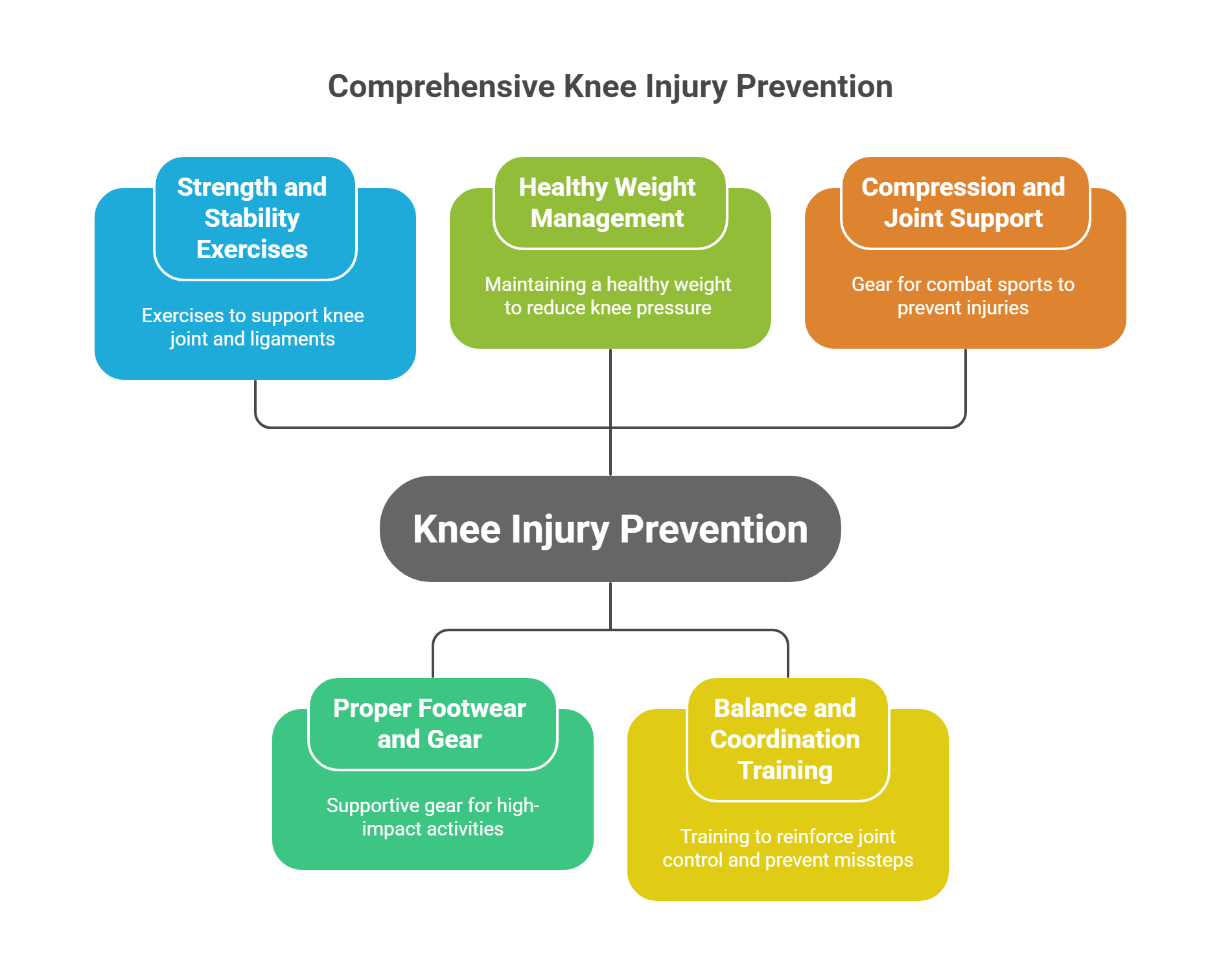
Long-term knee health isn’t just about recovery, it’s about prevention. Taking proactive steps now can help you stay strong, mobile, and injury-free down the road.
To protect and strengthen your knees, consider the following:
-
Incorporate knee-focused strength and stability exercises into your routine to support the knee joint and surrounding ligaments.
-
Wear proper footwear and supportive gear, especially during high-impact or lateral-movement activities.
-
Keep your weight in a healthy range to reduce pressure on your knees and minimize the risk of injury.
-
Train your balance and coordination regularly to reinforce joint control and prevent missteps that could lead to a sprain or worse.
If you're active in combat sports, MMA, or high-intensity training, gear matters. Quality compression and joint support can make a real difference in injury prevention and overall confidence.
Explore Anaconda Fightwear’s performance-engineered knee braces and compression gear, designed to help you stay supported, move freely, and push harder.
Final Words
Recovering from a sprained knee starts with the RICE protocol to reduce pain and swelling. Knee braces add support, while physical therapy and nutrition help restore strength and mobility. Gradually return to activity with proper gear and a focus on long-term knee health. Stay consistent, be patient, and take preventive steps to avoid future injuries.
Need reliable support? Anaconda Fightwear offers performance-grade knee gear designed for recovery and training.
Frequently Asked Questions
Quick answers to common knee sprain and recovery concerns.
What are the symptoms of a knee sprain?
The symptoms of a knee sprain typically include pain, tightness, swelling, stiffness, bruising, and a reduced range of motion. It’s important to seek medical attention if you experience these signs.
What is the initial action recommended post-knee injury?
Immediately following a knee injury, it is crucial to implement the RICE protocol: rest, ice, compression, and elevation, to minimize swelling and prevent additional damage.
What are common causes of knee pain?
Knee pain is often caused by injuries, overuse, or chronic conditions such as arthritis. Addressing these underlying issues is crucial for effective treatment.
What is the recovery time for a Grade 1 sprain?
A Grade 1 sprain typically requires 1-2 weeks for recovery. It's essential to rest, ice, compress, and elevate the affected area during this time.
Why is it important to consult a medical professional after a knee injury?
It's crucial to consult a medical professional after a knee injury to ensure an accurate diagnosis and to develop a customized recovery plan based on the injury's severity. This step can significantly impact your healing process and overall mobility.
![How to Heal a Sprained Knee Quickly [Expert Tips Inside]](http://anacondafightwear.co/cdn/shop/articles/how_to_heal_a_sprained_knee_quickly_320bc144-f519-4a94-a63a-e78ff3ed785d.webp?v=1763492262&width=2000)


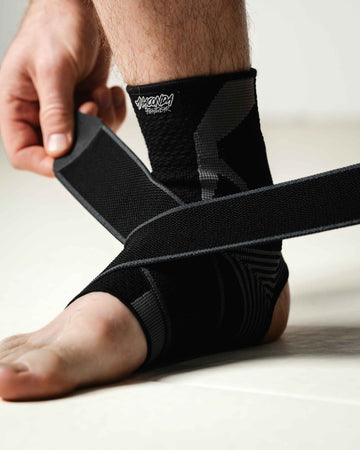



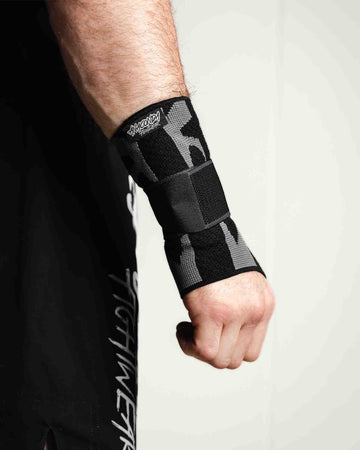

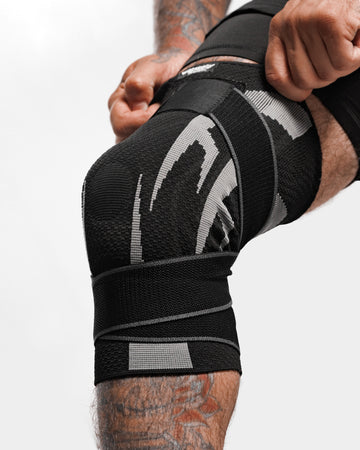



![How Long Does a Knee Injury Take to Heal? [Essential Insights and Tips]](http://anacondafightwear.co/cdn/shop/articles/How_Long_Does_a_Knee_Injury_Take_to_Heal.jpg?v=1764885786&width=533)
